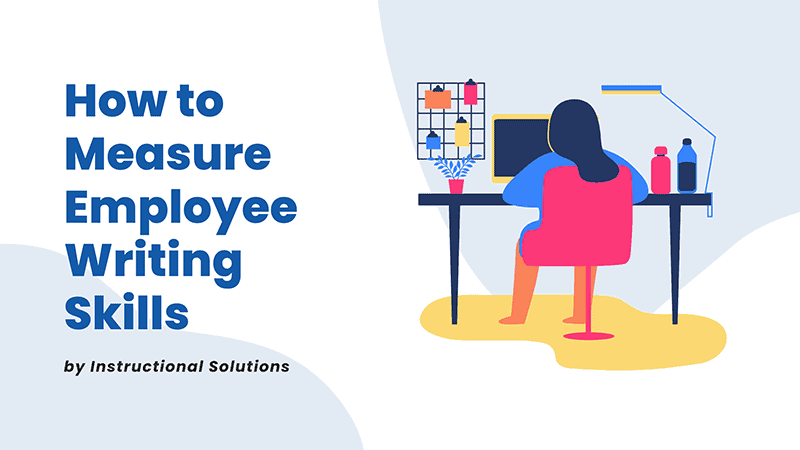How to Measure Employee Writing Skills

Writing with AI - Learn more


Of the many challenges a business faces when it comes to improving the business writing skills of its employees, the biggest challenge is selecting a yardstick for comparison. Since writing is subjective, deciding the appropriate standard to differentiate “good” business writing from “bad” business writing is difficult.
Similarly, “good business writing” appears to be a fuzzy concept that is difficult to measure. How can one define and measure good business writing skills?
Although improving business writing skills seems like an easy thing to do, it really isn't. Many senior executives and leaders struggle with large chunks of data and disparate information. They lack the ability to extract relevant information from mere noise and convert it into a meaningful, result-oriented message.
Forward-thinking managers will proactively develop their employees' writing skills to improve overall productivity. This article highlights the value of excellent business writing, includes a framework to assess writing quality, and offers a guide on improving employee business writing through practical training and tools.
Building strong business writing capacity in your team has significant benefits beyond the budgetary benefits described above. Improved writing leads to improved communication. Jeff Bezos is a business writing evangelist, requiring his now-famous executive memos in lieu of PowerPoint presentations because the writing process “forces better thought and better understanding.”
Poor writing, whether in a client proposal or an internal email, can lead to misunderstandings or incorrect interpretation of information. Improved business writing can avoid problematic errors, promote a healthier corporate culture, and ensure your business leaves a positive impression.
An employee training program can also attract talent. Modern employees are seeking companies that will support their professional development. A business writing development program has strong appeal due to the nearly universal need for this craft.
Business leaders understand the importance of "good business writing" skills and can differentiate good writing from bad. However, to improve your team's business writing skills, it's essential to measure them and develop metrics to track improvement.
Defining the proper measurements allows you to assess your team's current business writing performance level and helps improve business writing skills accordingly.
The first step is to measure the substance and syntax of the document separately. These are two distinct aspects of a document that are unique to business writing. The document can have good substance that is poorly worded. Conversely, a poorly worded document can lack substance.
Always remember that in business writing, substance precedes syntax. A document that has perfect syntax but meaningless substance is still going to fail to convey information. More worrisome, it may lead readers in the wrong direction, wasting time and potentially introducing risk and cost implications.
Once you are able to differentiate between substance and syntax, the next step to improve business writing skills of your employees is to specifically analyze the substance of your documents.
There are five crucial elements to substance that differentiate good business writing from bad.
These include:
Once you break down the substance according to these 5 elements, it becomes easier to assess the document and the skills of the writer. Using this baseline, you can identify writing gaps and deficiencies, thus informing business writing training emphasis.
Syntax is the last measurement step in analyzing the team's writing skills. Syntax is actually easier to measure and correct than substance errors. Employees who possess strong analytical skills – who often work in engineering, scientific, and finance positions – are naturally adept at integrating multiple concepts. This typically translates into strong substance. However, not all employees with analytical skills will also have clear syntax skills. But, it's easier for those employees with stronger analytical skills to quickly and easily improve business writing skills because they possess the raw requisite skills.
The concept of measurement is just as important in writing as in any other field. Using these steps, you can access the performance levels of your employees' business writing skills. However, do know that measurement alone is not enough. Measurement is just the start to better writing. Once you identify the gaps, you can then start the improvement process.
With new tools and technologies, measuring and improving syntax has become easier than before. Here are the two ways syntax in business writing can be measured:
Most writing software (including the very popular Microsoft Word) offers a readability tool to measure syntax. It will measure active voice and passive voice and the simplicity or complexity of sentence structure throughout the business document. This tool is also useful in assessing clarity.
If the passive voice score is high and sentence structures are complex, it clearly indicates that clarity is lacking.
Readability tools provide reporting on the words per sentence used, the percentage of passive sentences, and assign a readability score and grade to the overall document. When combined with the overall document content, this score helps you determine whether the appropriate message has been communicated in the document or not.
As a rule of thumb, remember these three tips:
Another easy-to-use tool to measure and improve syntax is to check the grammar in the document.
Thanks to Microsoft Word’s grammar check, some of the proofreading requirements have been reduced. It's ineffective and boring to teach your staff how to avoid spelling mistakes when a single red or green dotted line on the Word file highlights potential errors. Spellcheck or other proofreading tools, such as Grammarly, are far from infallible, but they will flag typos.
Tip: Watch for grammar error patterns in your own writing or your employees' writing. This will diagnose individual grammar errors, allowing you to focus on improving the issues that truly need attention.
Remember to focus first on substance in business writing training. Once the substance is verified, then use syntax rating tools, such as Microsoft’s Readability Index and simple grammar check to verify syntax.
All of our business writing courses teach critical thinking skills that produces substantive information that is tailored to the reader. Additionally, all courses address clarity, tone, format, persuasion, and all techniques that make a document a pleasure to read.
